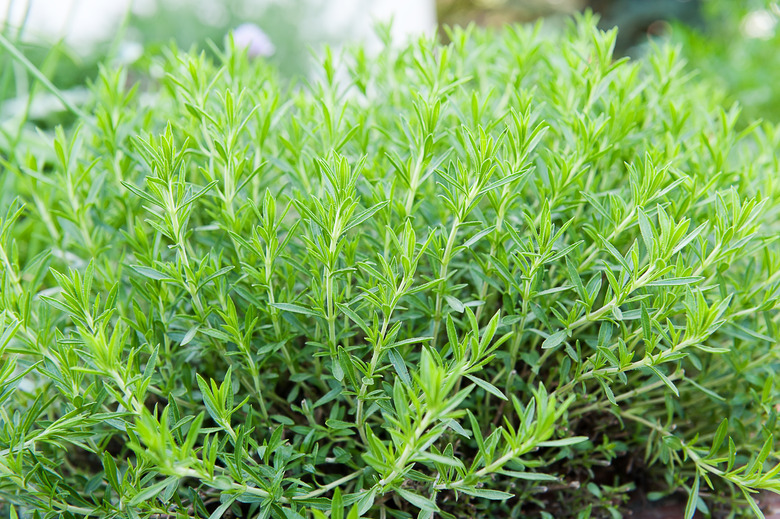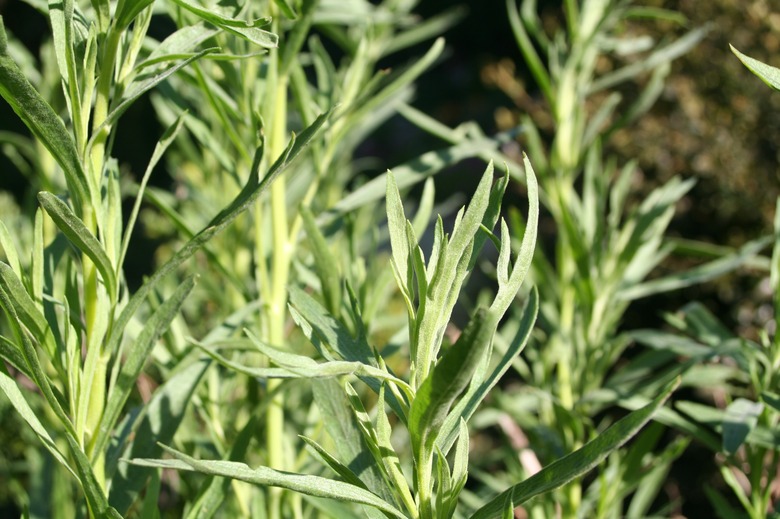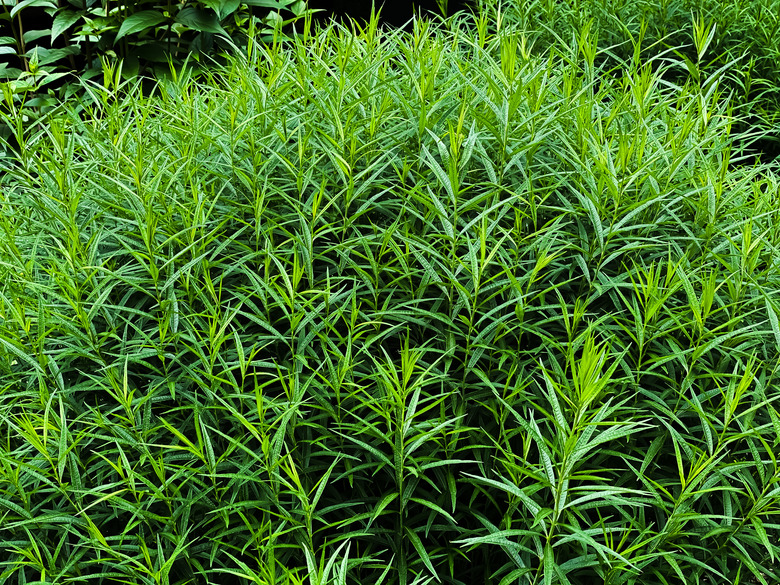How To Grow Tarragon
We may receive a commission on purchases made from links.
Known for its delightful licorice tang, tarragon (Artemisia dracunculus) graces many American herb gardens. A perennial herb in USDA zones 3 through 8, tarragon reaches heights of up to 3 feet and spreads to about half its height. If planted in the spring, most tarragon plants will reach their full size during the first growing season. Tarragon does require regular pruning to look its best but is an otherwise independent and easy-to-grow herb.
Best Uses for Tarragon
Best Uses for Tarragon
With basic skinny leaves and tiny white or yellow flowers, tarragon is not a particularly attractive plant, and it isn't grown as an ornamental. It is not so unattractive that you have to hide it in the garden, but most gardeners grow tarragon to eat it rather than admire it. Although you can grow it alone, tarragon goes nicely in a small herb garden where it can grow with other herbs. It's also a good companion plant for beans, tomatoes, parsnips, eggplant, and artichokes.
Tarragon often is used to flavor poultry and seafood, and it also pairs beautifully with tomato-based sauces and soups. Most gardeners find that two or three plants provide more than enough of the herb to satisfy their culinary needs.
How to Plant Tarragon Seed
How to Plant Tarragon Seed
Although the small greenish-yellow to white flowers are not showy, they do produce an abundance of seeds. Because it often self-sows, you can let the flowers drop their seeds, where they'll germinate in the soil around plants. You can also harvest the seeds from your own plants — or purchase tarragon seeds — and start them indoors. Here's how:
- Fill small pots or seed trays with seed-starting mix.
- Sprinkle the tarragon seeds on top.
- Cover the seeds only slightly with soil. Do this a few weeks before your area's last anticipated frost, usually in April or May for most gardeners.
- Place the pots or trays in a warm brightly lit spot, and keep the mix moist without letting it stay saturated.
- Once the seedlings start to sprout, thin them to one or two plants per pot, keeping the strongest and healthiest-looking seedlings and discarding the rest.
If you find that you have more tarragon than you need, consider gifting plants to friends and family members so they can start their own herb garden.
How to Plant a Tarragon Seedling
How to Plant a Tarragon Seedling
- Space your young tarragon plants 18 to 24 inches apart, planting them deeply enough to cover the entire root ball.
- Try to plant your tarragon at the same depth it was planted in its previous pot.
- Water the young plants deeply after planting and then leave them alone, letting the soil around them dry out completely before watering them again.
- Mulch around your young plants to conserve water and hold down weeds that could compete with them for soil nutrients.
You will want to plant your cuttings or seedlings outside after the danger of frost has passed. Work some compost into the soil before planting and if necessary, add peat moss or other organic matter to heavy soils to improve drainage.
In What Zone Does Tarragon Grow Best?
In What Zone Does Tarragon Grow Best?
Tarragon grows as a perennial herb in USDA plant hardiness zones 3 through 8. Gardeners outside this perennial range can grow tarragon indoors or plant it as an annual, enjoying this fresh herb during the summer and replacing the plant with a new one the next spring.
When Should You Plant Tarragon?
When Should You Plant Tarragon?
You want your tarragon to establish itself before winter weather hits, so plant it in early spring. You can plant tarragon a week or two after the final frost passes in your area. This is usually around Mother's Day in zone 5 but sooner in warmer zones and later in colder zones. However, if you have a hankering for this sweet herb and it's not the right growing season, you can always plant and grow tarragon in a sunny location indoors at any time.
Soil, Sunlight, and Water Recommendations for Tarragon
Soil, Sunlight, and Water Recommendations for Tarragon
Tarragon needs well-draining soil with a neutral pH between 6.5 and 7.5. It doesn't like wet or soggy soils, however, and will not perform in them. Amend your soil if it is heavy and holds water. If rain puddles hang around on the surface of your soil for more than 5 hours, your soil is absolutely too heavy for tarragon and needs to be amended. Once established, water your tarragon sparingly, allowing the soil to completely dry out between waterings.
Full sun is best for tarragon, but it will accept partial sun if it must. Fertilize your tarragon with a general-purpose fertilizer twice during the summer growing season and keep the plant trimmed as needed to keep it around 2 feet tall. Taller tarragon plants sometimes fall over, which just isn't an attractive look. Prune off any flowers that appear to promote leafier growth.
For bushier plants that produce more, pinch off the top leaves of young stems when they reach about 6 inches tall. In mid-June or when your plants reach their mature height, cut the entire plant back to 4 to 6 inches tall. This will produce a flush of new growth that you can harvest for immediate use or save for later by drying or freezing.
Dig up your tarragon plants and divide them every three or four years to keep them healthy and producing well. Older plants can start to grow too slowly and can fail to produce. Dividing the plant will fix this issue.
How to Propagate Tarragon
How to Propagate Tarragon
You can propagate tarragon through division or cuttings. Wait to divide the plant until it is about three or four years old, however. You can then dig up the plant and cut through its rhizomes (or horizontal, underground stems) to separate it and form new plants. Every division should have a clump of healthy roots and a few stems. Divide the root ball into halves or thirds depending on its size. It is best to divide tarragon very late in the winter, or, if you live in cooler zones, early in the spring.
To propagate tarragon from a cutting, take a 6-inch stem tip cutting in the spring or summer when the stem has toughened and become firm. Remove the leaves from the bottom half of the cutting, dip it in rooting hormone and then press it into the cutting mix. You can place several tarragon cuttings in the same pot if you wish, but giving each one its own separate pot eliminates the need to untangle plant roots before transplanting. While they establish themselves, tarragon cuttings do better with dappled sunlight than direct sun.
How to Winterize Tarragon
How to Winterize Tarragon
In zones 3 through 8, tarragon plants overwinter outdoors; however, in zones 3 and 4, it is a good idea to give your tarragon some extra insulation. In these colder zones, allow the plant to die back naturally in late fall. When it has, cut back any dead stems at ground level and then cover the plant with about 6 inches of mulch. This will add extra warmth and help keep your tarragon warm.
If you live in a climate outside tarragon's coldest winter-hardy limit, you will need to move your tarragon indoors for the winter. The easiest way to do so is to plant it in a container in the spring. That way, you won't have to dig it up later and hope it transplants well. You can also grow your tarragon as an annual by simply letting it die and replanting a new seedling next year.
How to Harvest Tarragon
How to Harvest Tarragon
Whenever you want a little tarragon for the kitchen, simply snip a few sprigs from your tarragon plant. You can harvest your plants as needed all season. Choose shoots that are about 6 inches long. Young leaves have a stronger flavor than older ones, but leaves of all ages are safe to eat.
As the season draws to a close, consider harvesting your tarragon plants and drying or freezing the leaves. You can also place tarragon leaves in a jar of white vinegar or oil to add flavor.
Common Pests and Other Problems for Tarragon
Common Pests and Other Problems for Tarragon
Tarragon typically enjoys a life free of insect pests. It may, however, attract a crowd of the usual aphids, thrips, and whiteflies that can visit any garden. These pests are usually inconsequential, but you can treat your plants with insecticidal soap if they are numerous or bothersome. You can often deter aphids simply by shooting them off your plants with a stream of water from a hose.
Common Diseases for Tarragon
Common Diseases for Tarragon
Tarragon is susceptible to various types of mildew, including downy mildew and powdery mildew. You can usually prevent these problems by thinning crowded plants to improve airflow and keeping your garden free of leaves, weeds and other debris. Avoid interacting with your plants when they are wet. If your plants get mildew in spite of your efforts, treat them with neem oil.
Rusts can also prove problematic for tarragon. The best way to prevent them is to dust your plants with sulfur early in the growing season. Once rust occurs, there is no easy fix. Remove affected leaves and stems immediately and if necessary, remove the entire plant before it can affect others in the garden.


